How corn is harvested for grain: timing and stages of the process, further processing and storage of the crop
Corn used for food, for the production of starch and molasses, and as feed for farm animals. The crop yield is high, on average 32-37 centners of grain per hectare. We will tell you in this article how to harvest and store corn in order to preserve the harvest for the maximum and for a long time.
Timing for harvesting corn for grain
Harvesting corn for grain begins when the seeds reach physiological (full) ripeness.
The harvest lasts about two weeks. The timing of the start of cleaning is calculated so that the work can be completed before the onset of prolonged rains and frosts.
Frozen seeds lose their viability. Harvesting wet corn leads to the spread of fungal diseases, which reduces the marketable value of the raw material.
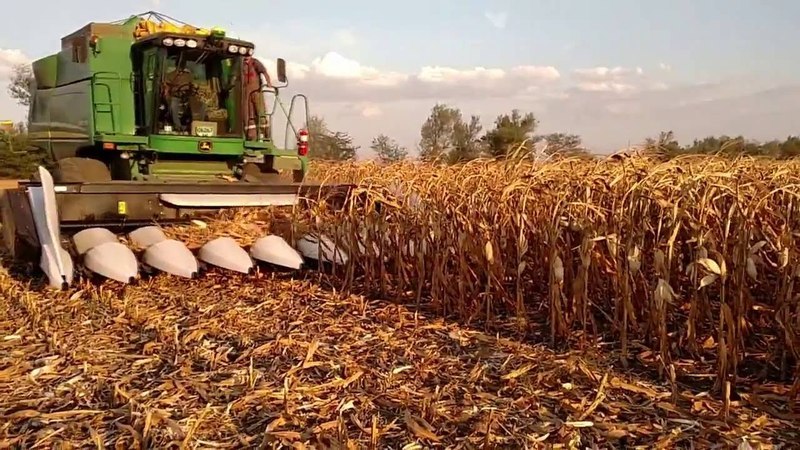
Stages of maturity
There are four stages of ripeness for corn:
- Dairy - characterized by the liquid consistency of the endosperm. When pressed, a milky white juice is released. Occurs 15-20 days after fertilization. The moisture content reaches 80%.
- Wax - occurs approximately 26 days after the start of pollination. The endosperm first resembles soft dough, then soft cheese and gradually thickens. The amount of sugar in fruits decreases, starch and dextrin are formed.
- Vitreous - lasts from 36 to 48 days from the moment the seeds begin to form. The grains begin to dry out and have a slightly wrinkled appearance.
- Full - usually occurs 55 days after pollination.The grains become hard and acquire a bright color. The leaves and cob wrapper turn yellow. Its weight at this stage reaches its maximum.
Determining the timing of the start of harvesting
The optimal time for harvesting corn is when the supply of nutrients ceases. During this period, the weight of the seed is maximum, the dry mass content reaches 60% and higher. The guideline for starting harvesting work is the appearance of a “black dot” at the base of the grain.
If the summer is cold, the cessation of nutrition occurs more slowly, so the black spot factor becomes unreliable. In this case, to decide on the start of harvesting, the sum of effective temperatures after the flowering of female inflorescences is taken into account. The biological maturity of corn grains occurs when this indicator reaches 800 ºС.
Reference. The sum of effective temperatures is the sum of average daily air temperatures exceeding the lower temperature limit of plant development for the growing season under consideration.
Harvesting begins earlier (at grain moisture content of 40-45%), if there is a risk of worsening weather conditions (early frosts, prolonged rains). When fruits dry to a moisture content of 18-20%, losses increase.
Advantages and disadvantages of early and late collection
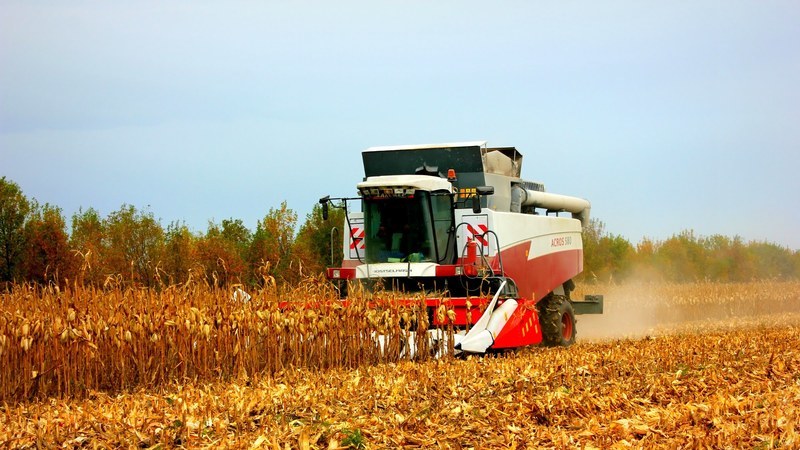
| Advantages | Flaws | |
| Too early |
|
|
| It's too late |
|
|
Process technology
Harvesting grain corn consists of the following technological operations:
- field preparation;
- cutting and cleaning cobs;
- threshing;
- collection and grinding of plant residues.
The last three, as a rule, are performed together on one harvesting unit.
Important! The grain must be processed within four hours of collection. Due to the high humidity of raw materials, they deteriorate - the appearance of mold, mildew, and rancidity.
Field preparation
At the stage of preparing the field for harvest, the optimal direction of movement of the combines is determined. Most often it coincides with the direction of sowing. They make swaths along the edge of the field and prepare headlands.
Next, the width of the paddocks is set: it is 6-12 times less than the length of the paddock and a multiple of the double working width of the harvesting machine. It is not allowed for butt row spacing to be caught in the gripper. The number of pens must be a multiple of or equal to the number of combines in the link.
When the length of the headland is more than 1000 m, transport and unloading highways 7-8 m wide are mowed every 500-600 m.
Combine harvesting with cob threshing
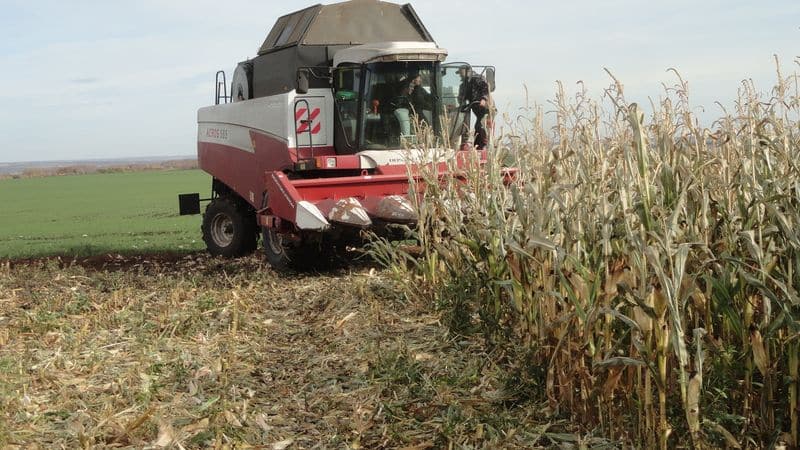
In this way, grain is harvested with humidity up to 30%. Since harvesting, peeling of cobs and threshing are combined into one operation, culling of cobs is not performed and the product is used only for fodder purposes.
Self-propelled combines KSKU-6 are used for harvesting and threshing. The feed chains of the header introduce the stems into the cob pickers. The stems are pulled through the slits of the fragmentary plates, the cobs are separated, and the cutting apparatus cuts the stems at a height of 15 cm from the soil surface.
The cobs are transported to an auger, which distributes them onto conveyors. The cobs are partially cleared of the remains of stems and leaves by stem catchers installed in the upper part of the conveyors and enter the thresher.The threshed grain is transported through the unloading conveyor into the combine cart, and the cores and cob wrappers are dumped onto the field.
The stems are sent to a drum-type chopper. The crushed plant residues are thrown through a silo into the back of a nearby car or tractor.
Agrotechnical requirements for combine harvesting with threshing:
- grain loss behind the combine - no more than 0.7%;
- underground - no more than 1.2%;
- crushed grain content - no more than 2.5%;
- seed content in the silage mass - no more than 0.8%;
- degree of purification - no less than 97%.
Combine harvesting cobs
Harvesting cobs without threshing is used for food and seed grains. This method is applicable when seed moisture is 35-45%.
The cobs are collected using Khersonets-7V combines or grain harvesting units with the PPK-4 attachment. The operation of these machines is similar to the operation of KSKU-6. The difference is that the separated cobs do not go into the thresher, but into the cob peeler.
Drying and threshing of cobs occurs at stationary post-harvest processing and storage points.
Agrotechnical requirements for harvesting cobs:
- the content of peeled cobs in the heap is at least 95%;
- the proportion of broken cobs is no more than 5%;
- The purity of the heap is at least 99%.
Most harvesting units are designed for corn sowing with a row spacing of 70 cm and a distance between plants of at least 20 cm.
Modern combines ensure the collection of the entire biological crop up to 20 tons per hectare.
Post-harvest treatment
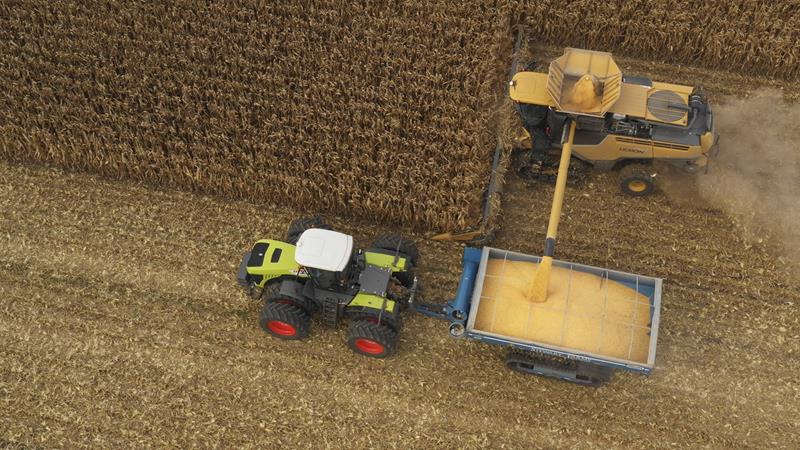
Post-harvest grain processing includes cleaning and drying.
Cleaning
Cleaning is divided into:
- preliminary - clean the freshly harvested or wet mass before drying;
- primary - all types of impurities are separated and the main grain is isolated;
- secondary - sort the product into fractions.
Air sieve separators are the main equipment for cleaning raw materials. All light organic impurities, too small and too large grains are separated.
The units consist of aspiration channels and a set of sieves with different cell sizes. During the cleaning stage, movements are kept to a minimum, especially through high-performance elevators and augers, to prevent mechanical damage to the product.
The productivity of modern equipment for cleaning is 10-15 tons per hour, for sorting - 20 tons per hour.
Drying
Depending on the humidity, the harvested grain is sent for storage or processing.
At a humidity of 14-15%, corn is sent for storage, at a humidity of 15-17% - for drying or ventilation, at a higher humidity - only for drying.
Ventilation is effective for processing products with humidity 1-5% above normal. In the drying mode, the raw materials are blown with warm atmospheric or slightly heated air.
For drying, shaft, column or bunker type dryers are used.
Soft modes are used, grain heating is allowed:
- for feed purposes - no higher than 50 ºС;
- for starch and syrup production - no higher than 45 ºС;
- for the food industry - 35 ºС.
In addition to the temperature regime, it is necessary to ensure optimal moisture transfer. During one pass through the dryer, moisture loss should be 4.5-5.5%. If the corn is not dried in one go, it is processed in several passes.
After drying, the grain must be cooled. The temperature at which corn is allowed to be placed in storage should not be higher than the ambient temperature by more than 8-10 ºС.
Read also:
Is it possible to eat boiled corn if you have pancreatitis?
Further storage
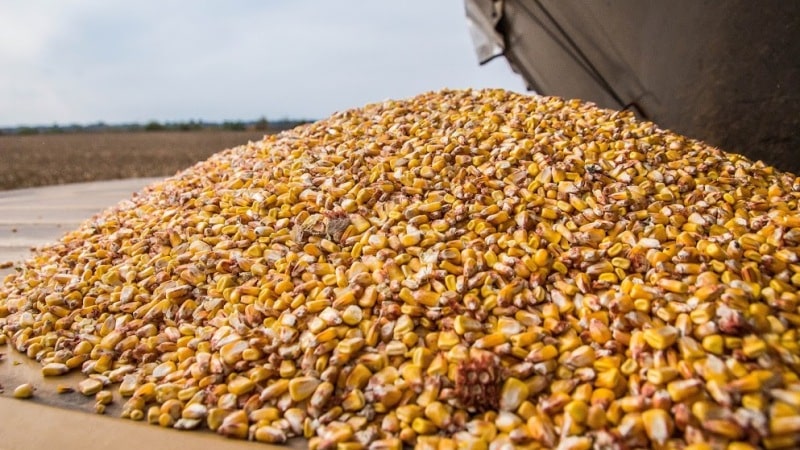
Corn grain is stored in bulk in warehouses, in elevator silos, and in bunker storage facilities.
Feed grain is stored at a humidity of 15-16%, food grain - at 14-15%.
For storage up to a year, raw materials with a moisture content of 13-14% are allowed, over one year - 12-13%.
Quality control
During the storage period, control the temperature, humidity, color, smell, and purity of the product. Particular attention is paid to indicators of pest and disease infestation.
The quality of corn must comply with the standards established by GOST 13634-90 “Corn. Requirements for procurement and supply." The standard applies to corn in grain and on the cob, harvested and supplied for food, feed purposes and for processing into animal feed.
The basic norms in accordance with which payments are made for commercial corn grain are given in the table.
| Indicator name | Norm |
| Grain moisture, % | 14,0 |
| Weed impurity, % no more | 1,0 |
| Grain admixture, % no more | 2,0 |
| Pest infestation | Not allowed |
Conclusion
Timely harvesting of corn allows you to maintain maximum yield. The main criteria for establishing the beginning of the harvest is the biological ripeness of the seeds.
Harvesting from the fields is done by combines. Threshing of cobs is carried out using combines on the field or at stationary points. The harvested crop is stored in elevators or in special granaries. Compliance with agrotechnical standards at all stages of cultivation, harvesting and storage guarantees the preservation of the commercial properties of corn for a long time.